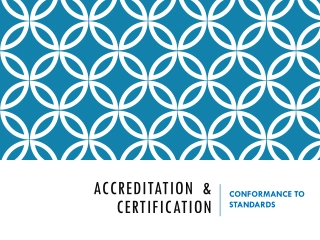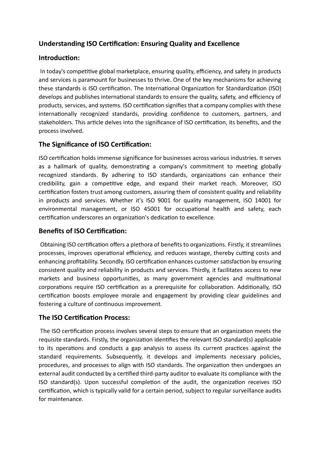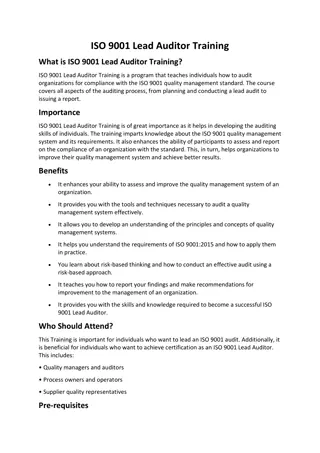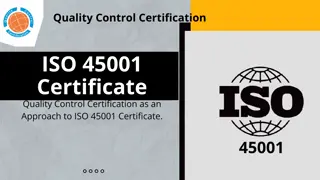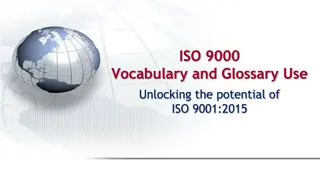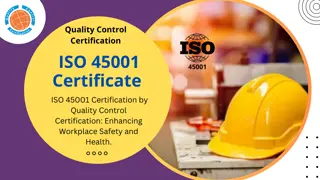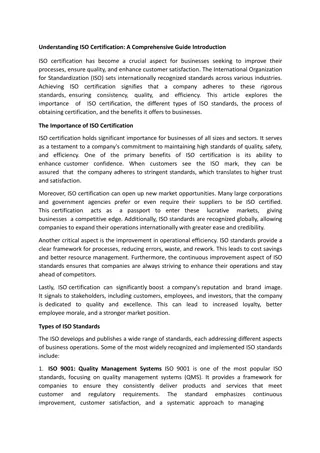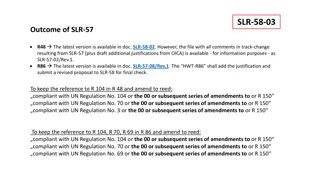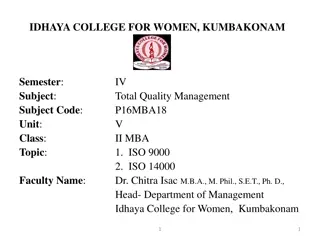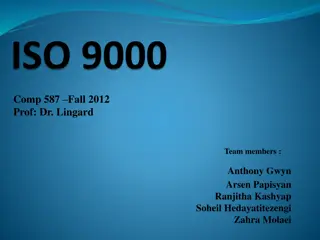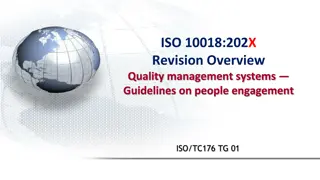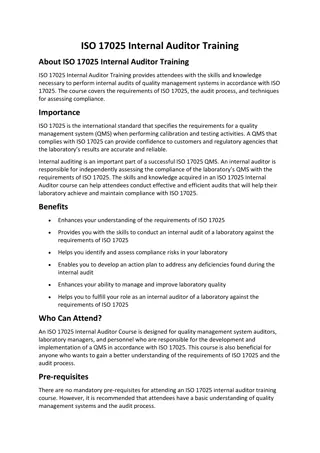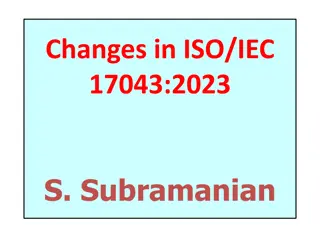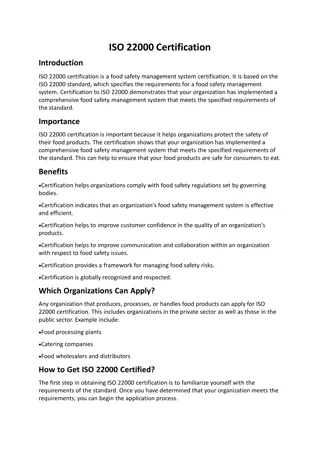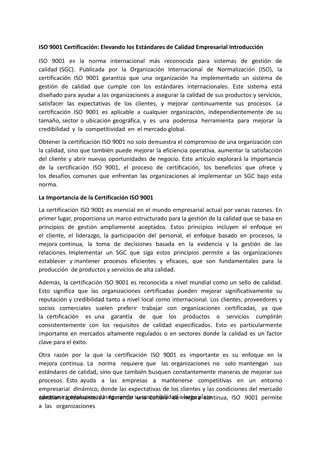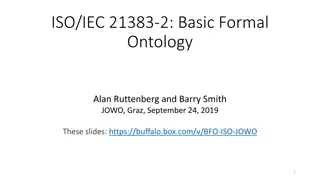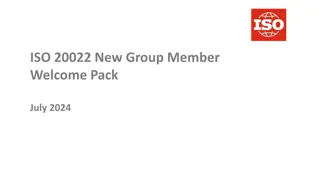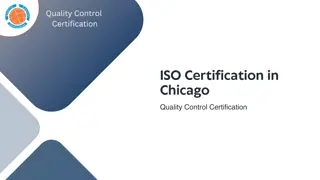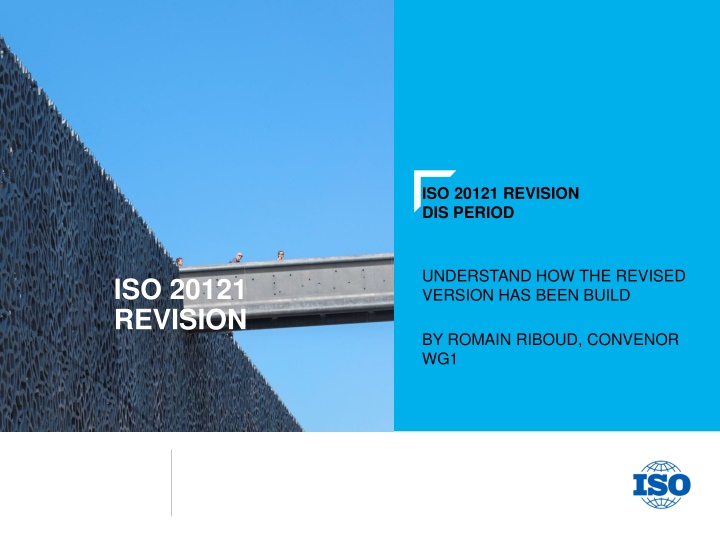
ISO 20121 Revision Overview
The revised ISO 20121 standard, led by Romain Riboud, convenor of WG1, focuses on aligning with global sustainability frameworks, enhancing impact assessments, and improving user accessibility. The work areas include sustainability alignment, impact assessment, and user accessibility improvements.
Download Presentation

Please find below an Image/Link to download the presentation.
The content on the website is provided AS IS for your information and personal use only. It may not be sold, licensed, or shared on other websites without obtaining consent from the author. If you encounter any issues during the download, it is possible that the publisher has removed the file from their server.
You are allowed to download the files provided on this website for personal or commercial use, subject to the condition that they are used lawfully. All files are the property of their respective owners.
The content on the website is provided AS IS for your information and personal use only. It may not be sold, licensed, or shared on other websites without obtaining consent from the author.
E N D
Presentation Transcript
ISO 20121 REVISION DIS PERIOD UNDERSTAND HOW THE REVISED VERSION HAS BEEN BUILD ISO 20121 REVISION BY ROMAIN RIBOUD, CONVENOR WG1
C1-INTERNAL AGENDA WHAT YOU WILL GET FROM THIS MEETING ? THE REVISION TIMELINE SO FAR HOW THE REVISION HAS BEEN WORKED BY THE WG1 WHAT ARE THE MAIN WORK AREAS/AXIS Page 2
C1-INTERNAL TIMELINE 6/12/22 6/12/22- 06/03/23 6 to 31 March 23 2 May 23 Systematic Revue Ballot closed Preparation work UK/FR to build a first WD based on 3 axis WG meeting to collectively finalize the WD DIS ballot Page 3
C1-INTERNAL ISO/PC 250/WG 1 3 THEMATIC AXES THEMATIC REVIEW OF THE REVISED NORM BASED ON THREE PROPOSED AREAS OF REVISION: > Work on Axis 1 : Global sustainability framework alignment (SDGS) > Work on Axis 2 : Impact Assessment (ESG impact) > Work on Axis 3 : User accessibility improvement ISO/PC 250/WG1 ISO 2023 Page 4
C1-INTERNAL UNDERSTAND HOW THE WD HAS BEEN BUILT The WG based on the French/UK proposal worked on 3 axis to guarantee that the norm accurately reflects a comprehensive, practical and forward-thinking standard that can be used as a framework for making events more sustainable globally. 1.Global Sustainability Frameworks: Since the norm was released in 2012, we now have the UN Sustainable Development Goals and numerous sustainability frameworks that affect the events sector. The norm needs to integrate the requirements expected by the international community of the event sector, and to reinforce reference to normative (legal and policy) frameworks to avoid greenwashing and assist events. 2. Impact Assessment: The norm requires greater consideration of social issues, frameworks and impact e.g. human rights, impact on local communities. The norm needs to ensure that reference to the Environmental, Social and Governance (ESG) impact and legacy of an event is reinforced. 3. User accessibility: The norms needs to reflect a changing events sector, that includes virtual and hybrid events. Need to ensure that the requirements of ISO 20121 remain relevant and applicable to a broad range of events & events organisers (size and budget). Alignment or reference to key sustainability standards including ISO standards, good practice will enable greater user accessibility and inspire all stakeholders. Need to create a community around the norm Page 5 ISO/PC 250/WG1 ISO plenary 2023
C1-INTERNAL HOW THE 3 AXIS HAS BEEN ADRESSED DURING WG WORKING SESSIONS ? Page 6
C1-INTERNAL 3 AXES ANALYSIS The revision process has sought to address these 3 broad needs and can be summarised as follows: Axes of Analysis Revisions proposed Eight (8) proposed revisions including: 1. Global Sustainability Frameworks 2 revised definitions: 3.2 sustainability, 3.3 sustainable development and 4.1 Understanding the organization and its context: now include reference to SDGs. Revised Annex A.11 Legal and other requirements includes a list of legal frameworks and guidance that may be relevant to the implementation of ISO 20121 including SDGs, Convention on the Rights of Persons with Disabilities (2006) Convention on the Elimination of All Forms of Discrimination against Women (1979), Convention on the Rights of the Child (1989) [...] ISO standards supporting the UN SDGs e.g. UN SDG no.1: ISO 20400 Sustainable procurement Guidance Added human rights to Annex C. Table C.1 List of issues for organizations to consider in fulfilling issue identification and evaluation. New Annex C.3 Guidelines on Reporting (see Axe 2 below) that refer to relevant frameworks (SDGs, ISO, GRI etc). Added reference to relevant ISO standards e.g. 3.16: definition of inclusivity ; 8.3. Supply Chain management. Page 7 ISO/PC 250/WG1 ISO plenary 2023
C1-INTERNAL 3 AXES ANALYSIS Axes of Analysis Revisions proposed Sixteen (16) proposed revisions including: 3 revised definitions: 3.18. Legacy; 3.19 stewardship; 3.42 impact 2 new definitions: 3.43 Statement of Purpose; 3.44 Mission statement. Impact integrated into: 4.1. Understanding of the organization and its context; 4.5 Sustainable development principles, statement of purpose and/or, mission and values; 5.2 Policy. To ensure accurate reporting of impact (i.e. to avoid greenwashing) 7.4 Communication, added new: The communications shall include, where appropriate, the following: g) progress in relation to performance; [...] NOTE: To ensure responsible communication, attention must be taken to ensure that there is no communication made that may mislead the public on the real environmental quality and social positive impact of a product or a service or on the reality of an organization's sustainable development approach, regardless of how it is communicated. New Annex C.3 Guidelines on Reporting: If an organisation subscribes to a reporting regulation, it should report in compliance with it. Examples of international and regional reporting frameworks include (non-exclusively): the GRI Sustainability Reporting Standards (GRI Standards), for GHG emissions, refer to the "Net Zero Carbon Events" initiative (hosted by the Joint Meetings Industry Council and supported by UNFCCC), the UN SDGs, the UN FCCC Sports for Climate Action Framework, the European Sustainability Reporting Standards (ESRS). [...] 2. Impact Assessment Page 8 ISO/PC 250/WG1 ISO plenary 2023
C1-INTERNAL 3 AXES ANALYSIS Axes of Analysis Revisions proposed 3. User Accessibility Four (4) proposed revisions Definition of 3.7 event includes planned physical, digital or hybrid gathering Clarification of processes and documents required includes specification of the forms of engagement with interested parties (4.2): engagement with interested parties may take different forms such as: verbal conversation, written correspondence, meetings, working groups, certification labels and Awards, progress plans ; that not all the system must be document (4.4) and the necessity of appropriate resources (7.1). Revised Annex A.11 Legal and other requirements for inspiration and good practice (see Axe 1) Clarifications related to the Audit process of the norm (principally section 9) will be dealt with by a Conformity Task Force led by the Swiss. Page 9 ISO/PC 250/WG1 ISO plenary 2023
C1-INTERNAL APPENDIX Page 10
C1-INTERNAL DETAILS OF THE ANALYSIS For each workline, we have identified: 1. What was missing in the norm? 2. How was it addressed? 3. Details of the General Comments made to date. Global Sustainability Frameworks User Impact Assessment accessibility Page 11 ISO/PC 250/WG1 ISO plenary 2023
C1-INTERNAL Global Sustainability Frameworks (UN SDGs etc) AXIS 1 : GLOBAL SUSTAINABILITY FRAMEWORKS 1. - - What was missing in the norm? 17 Sustainable Development Goals, launched after ISO20121; Need to reinforce reference to other normative (legal and policy) frameworks to avoid greenwashing and assist events. 1. - How has it been addressed? 3.2: definition of sustainability, added Note 1 to entry: When considering sustainability, reference could be made to applicable normative and legal frameworks such as the UN Sustainable Development Goals (SDGs), See Annex A. - 3.3: definition of sustainable development, added Note 2 to entry: Depending on the activity considered, the entity could take into account the most relevant UN SDGs when defining its sustainable development policy. - 3.16: definition of inclusivity. Note 2 to entry: For further information, see ISO 53800 Guidelines for promotion and implementation of gender equality and women s empowerment (ISO 53800 is currently in development by ISO/PC 337, and is at the Committee Draft stage). - 4.1 Understanding the organization and its context: Added: Note 1 to entry Consideration of the UN s SDGs and other relevant frameworks can assist in determining the issues to be addressed. See Annex A.11 - 6.1.2 Issue identification and evaluation. Revised: NOTE 2 See Annex C for further guidance. The list of issues contained in Table C.1 is non-exhaustive. Event organisers, particularly major international events, are encouraged to consider a maximum of sustainability issues when developing their event management system - 8.3. Supply Chain management. Added: NOTE For further information on supply chain management, and on evaluations of suppliers performance post-events, see Annex B and ISO 20400 Sustainable procurement. Page 12 ISO/PC 250/WG1 ISO plenary 06 Mar- 10 Mar- 2023
C1-INTERNAL Global Sustainability Frameworks (UN SDGs etc) AXIS 1 : GLOBAL SUSTAINABILITY FRAMEWORKS Revised Annex A.11 Legal and other requirements: Examples of other requirements to which the organization may subscribe include: Added: Universal accessibility codes and regulations. Added a list of legal frameworks and guidance that may be relevant to the implementation of ISO 20121 including (non-exclusive): UN Sustainable Development Goals (SDGs) Convention on the Rights of Persons with Disabilities (2006) Convention on the Elimination of All Forms of Discrimination against Women (1979) Convention on the Rights of the Child (1989) [...] ISO standards supporting the UN SDGs e.g. UN SDG no.1: ISO 20400 Sustainable procurement Guidance Annex C. Table C.1 List of issues for organizations to consider in fulfilling issue identification and evaluation, revised to include: reference to Human rights: rights inherent to all human beings, regardless of race, sex, nationality, ethnicity, language, religion, or any other status. Other references in the norm to global sustainability frameworks that remain unchanged include: 3.14 accessibility 3.20 transparency 3.22 supply chain Page 13 ISO/PC 250/WG1 ISO plenary 06 Mar- 10 Mar- 2023
C1-INTERNAL Global Sustainability Frameworks (UN SDGs etc) AXIS 1 : GLOBAL SUSTAINABILITY FRAMEWORKS Comments received: FR SR: Strengthen the legitimacy of the standard by harmonising it with the UN Sustainable Development Goals, on the issues that all event stakeholders wish to take into account. BR -SR: Several updates are necessary for the standard to align with global best practices, new post-pandemic sector requirements and new standards, international agreements and Recommended Practices relevant to the events sector developed after the launch of ABNT NBR ISO 20121. 1. The 17 Sustainable Development Goals, launched after ISO20121; CH - SR 023: the standard needs to be linked with the UN Sustainable Develompent Goals (SDGs). [...] IT - SR 019: The ISO 20121 has relation with the future, so the only standard that manage future for SDG and Sustainability is ISO 17029. FR 003: Global Frameworks. Need to align with and incorporate reference to current global sustainability frameworks, laws, goals & reporting standards, potentially in an Annex and in Notes throughout the norm without making compliance with the specific framework a condition for certification. Proposed reference to frameworks that reinforce the linkage of the norm to the UN SDGs, UNFCCC Race to Zero, relevant ISO standards e.g., ISO 26000, ISO 14001, ISO 37000 Page 14 ISO/PC 250/WG1 ISO plenary 06 Mar- 10 Mar- 2023
C1-INTERNAL Global Sustainability Frameworks (UN SDGs etc) AXIS 1 : GLOBAL SUSTAINABILITY FRAMEWORKS FR 012: Introduction. There is no reference to an international standard (SDG, Net Zero carbon events pledge and so on.) or Planetary boundaries FR 218: 4.5 There is no reference to any international standards or concepts, such as SDGs. We could add a reference in order to have a better integration of sustainability and to anchor ISO 20121 to international actions and global agreements. GB-SR 030: Align with current global sustainability frameworks, goals & reporting standards. e.g., UN SDGs, UNFCC Race to Zero Seek to align or reference other key sustainability standards. e.g., ISO 26000, ISO 14001, ISO 37000 FR06: Role of the norm as a gatekeeper for sustainable events and organisations. At the heart of the norm is the need to focus on the why , the purpose and impact of the event/organisation and not only on the how an organisation is deemed sustainable. The norm deals essentially with doing things right , instead of also dealing with doing the right things . Focus is needed on the purpose, context, prioritisation of the most relevant themes and articulation between sustainable development and the impact of an event in the short, medium and long terms. To ensure that the norm is utilised and promoted by ethical, credible and sustainable organisations and events, it is recommended that from the conception of the event to the legacy phases, strong governance requirements are made to ensure sustainability is integrated within the regulations and culture of the organisation. By ensuring transparency around governance, sustainability will not only be linked with communication but also the operational impact of the norm. Page 15 ISO/PC 250/WG1 ISO plenary 06 Mar- 10 Mar- 2023
C1-INTERNAL AXIS 2 : IMPACT ASSESSMENT Impact Assessment What was missing in the norm? - Need to ensure reference to the impact and legacy of an event is included - Need to enhance reference to social issues and frameworks How has it been addressed? - 3.18. definition of Legacy. Revised Note 1 to entry: social and environmental impacts of an event or events. Note 2 to entry: Soft legacy also includes non-material elements, including new capacities acquired as a consequence of events, e.g. new knowledge, training, standards, best practices, skills, organizations (3.1), systems, relationships, partnerships and innovations. Note 3 to entry : Legacy includes planned and unplanned results of hosting an event on interested parties (3.15). Legacy may be of greater relevance to larger events and should be considered in the issue identification and evaluation (A.10). Hard legacy includes the enduring physical, economic, - 3.19 definition of stewardship revised: responsibility, management and care for sustainable development (3.1.3) shared by all those whose actions affect environmental performance, economic activity, and social progress, reflected as both a value and a practice by individuals, organizations (3.1.1), communities, and competent authorities - 3.42 definition of impact revised: positive or negative change to the society, economy or the environment, wholly or partially, resulting from an organisation s (3.1) past and present decisions and activities. Note 1 to entry: The impacts can be negative or positive, short-term or long-term, intended or unintended, and reversible or irreversible. Note 2 to entry: Society includes the host community and refers to the local population or those directly involved with the event.Note 3 to entry: see Annex C (Guidelines on Reporting). - added: 3.43 Statement of Purpose. A declaration of the organisation s reason for existence. - added 3.44 Mission statement. Specifies what the organisation does to achieve its purpose and/or vision. Page 16 ISO/PC 250/WG1 ISO plenary 06 Mar- 10 Mar- 2023
C1-INTERNAL AXIS 2 : IMPACT ASSESSMENT Impact Assessment How has it been addressed? - 4.1. Understanding of the organization and its context. Revised: [...] This shall include consideration of its social, economic, and environmental impacts. - 4.5 Sustainable development principles, statement of purpose and/or, mission and values. Revised to [...]The organization shall define and include in documented information its primary purpose, mission, its social, environmental and economic benefits, and values with respect to its activities, products and services that relate specifically to events. - 5.2 Policy. new [e] commitment to take in consideration the needs legacy issues; [NB: language needs to be corrected] - 6.1.2 Issue identification and evaluation. Amended a) b) and c) with new NOTE 2. See Annex C for further guidance. The list of issues contained in Table C.1 is non-exhaustive. Event organisers, particularly major international events, are encouraged to consider a maximum of sustainability issues when developing their event management system. 6.2 Event sustainability objectives and planning to achieve them. Revised The event sustainability objectives shall: e) be monitored; Page 17 ISO/PC 250/WG1 ISO plenary 06 Mar- 10 Mar- 2023
C1-INTERNAL Impact Assessment AXIS 2 : IMPACT ASSESSMENT 7.4 Communication. added new: The communications shall include, where appropriate, the following: g) progress in relation to performance; [...] NOTE: To ensure responsible communication, attention must be taken to ensure that there is no communication made that may mislead the public on the real environmental quality and social positive impact of a product or a service or on the reality of an organization's sustainable development approach, regardless of how it is communicated. See also Annex C.3 [Guidelines on Reporting] 9.1 Monitoring, measurement, analysis and evaluation. Revised: The organization shall determine:[...] Documented information shall be available as evidence of the results. 9.2.3 Performance against governing principles of sustainable development. Revised: NOTE 1 : Evaluations of performance may include future and current performance Annex A. Table A.2 : Integrity revision from CH to be integrated. Annex C. Table C.1 added human rights. Annex C. added new C.3 Guidelines for reporting [...] regulation, it should report in compliance with it. Examples of international and regional reporting frameworks include (non-exclusively): the GRI Sustainability Reporting Standards (GRI Standards), for GHG emissions, refer to the "Net Zero Carbon Events" initiative (hosted by the Joint Meetings Industry Council and supported by UNFCCC), the UN SDGs, the UN FCCC Sports for Climate Action Framework, the European Sustainability Reporting Standards (ESRS). [...] If an organisation subscribes to a reporting Other references in the norm to ESG impacts that remain unchanged include: 3.31 performance measurable result. Note 1 to entry: qualitative findings Performance can relate either to quantitative or Page 18 ISO/PC 250/WG1 ISO plenary 06 Mar- 10 Mar- 2023
C1-INTERNAL Impact Assessment AXIS 2 : IMPACT ASSESSMENT Comments received: FR 004: Need to enhance reference to social issues and frameworks related to e.g. universal accessibility, social impacts, legacy (short, mid, long term impact), engagement with state entities, youth, wellbeing, physical and mental health, citizens, quality of life, economic benefits, and alignment with state objectives (as often the principal funders of events), LGBTQIA,, Diversity, Equity and Inclusion (DEI) (see 6.1.2 for comprehensive list). FR 011. Introduction. Need to reinforce the link with positive impacts and benefits of the event. Need to ensure that sustainability issues are (or should be) an essential prerequisite when considering the short, medium and long term impacts of the event or organisation.. FR 013. Introduction. We could add: continual performance improvement, WHILE reducing negative impacts and aiming positive ones NO SR 021 [...] The standard should be considered revised to include:Climate actions supporting ISO London Declaration since this is considered to have a high impact on sustainability and climate CH Comment (07.03.23 via email): 3.42 impact Proposed definition: Effect an organization has or could have on the economy, environment, and society. Note 1 to entry: The impacts can be actual or potential, negative or positive, short-term or long-term, intended or unintended, and reversible or irreversible. GB 101-105. 105: Update the legacy definition to read: resulting remains of an event (3.1.4) Note 1 to entry: Legacy includes the enduring physical, economic, social and environmental impacts of an event or events. ISO/PC 250/WG1 ISO plenary 06 Mar- 10 Mar- 2023 Note 2 to entry: Legacy also includes non-material elements, including new capacities acquired as a consequence of (because of concise) events, (e.g. new knowledge, training, standards, best practices, skills, organizations (3.1.1) systems, relationships, partnerships and innovations.) Page 19
C1-INTERNAL Impact Assessment AXIS 2 : IMPACT ASSESSMENT Comments received: GB 180. 3.42. Group Impact under Terms related to Context (Clause 4) GB 181 Update the impact definition to read: positive or negative change to society, economy or the environment, wholly or partially resulting from past and present decisions and activities CN 319. Table C.1. The issues in the table are not uniform, some are actions, some are impacts, and some are overlapping. Propose to Reclassify them with issues in ISO 26000 or SDGs. Page 20 ISO/PC 250/WG1 ISO plenary 06 Mar- 10 Mar- 2023
C1-INTERNAL Impact Assessment AXIS 2 : IMPACT ASSESSMENT Avoid Greenwashing - to ensure ESG impacts are addressed both in procedures and in operation. FR 008: Need to better structure the audit process including reference to mandatory requirements of the norm, focus on the system and if possible, compliance with the system to avoid greenwashing. DE-SR 025: The New Consumer Agenda (277) and the Circular Economy Action Plan 2020 (278) contain further proposals to combat greenwashing. The Commission is also working on initiatives such as establishing standards for certifying carbon removal (279). DE-SR 027: See Green Transition Consumer Empowerment Policy. The main goal of the Sustainable Products Initiative (SPI) is the introduction of sustainability requirements for products that are placed on the market and is thus aimed at suppliers and manufacturers. We would like to refer in particular to the following annexes of the SPI: 2.2.A: Ban on general/vague environmental claims, impact on consumers: [...] By banning such vague claims (unless there is strong evidence of a product's environmental credentials), the option prevents consumers from making decisions based on unreliable information and also highlights which products are truly 'green'. The option should have a positive impact on consumer decision-making. DE-SR 028: The European Commission will better protect consumers from unfair commercial practices such as greenwashing, premature obsolescence of consumer goods or non-transparent voluntary sustainability labels and digital information tools that are incompatible with the green transition. DE-SR 029: [...] The European Commission has become aware of this topic and has already submitted initial proposals on how greenwashing can be curbed in the future. When revising the standard, it must therefore be ensured that it is in line with the objectives of the European Commission. FR 273: 7.4 We could add reference to responsible communication and prohibition of greenwashing. For instance, we may refer to ADEME documentation on responsible communication: https://librairie.ademe.fr/consommer-autrement/5818-le-guide-de-la- communication-responsable-nouvelle-edition-enrichie-9791029715730.html Page 21 ISO/PC 250/WG1 ISO plenary 06 Mar- 10 Mar- 2023
C1-INTERNAL Impact Assessment AXIS 2 : IMPACT ASSESSMENT Human Rights GB- SR 030: Enhance social impact considerations. e.g., Human & child labour, local communities. BR -SR 017: 4. Increased human rights requirements based on guidance created by Unicef after ISO20121; GB 253: 6.1.2: Remove, human rights, child rights, citizens, quality of life and replace with, human and child rights . Remove practices for people with disabilities, accessibility, youth wellbeing, legacy, engagement with state entities, alignment with state objective, LGBTQLA, Diversity, Equity and Inclusion (DEI), social impacts Page 22 ISO/PC 250/WG1 ISO plenary 06 Mar- 10 Mar- 2023
C1-INTERNAL User AXIS 3 : USER ACCESSIBILITY accessibility What was missing in the norm? Need to create a community around the norm Need to reflect a changing events sector, including hybrid & virtual events; Need to ensure that the requirements of ISO 20121 remain relevant and applicable to a broad range of events & events organisers (size and budget). How has it been addressed? Task Force on Compliance to provide hopefully clarity around necessary documents for audit, number of audits etc. 3.7 event planned physical, digital or hybrid gathering with respect to time and a place where an experience is created and/or a message is communicated 4.2 Understanding the needs and expectations of interested parties. Revised: The organization shall detail document in documented information the outputs from its engagement with interested parties (see 7.3, 7.4 and 8.3) [...] including d) partners; e) sponsors. Added new: NOTE: engagement with interested parties may take different forms such as: verbal conversation, written correspondence, meetings, working groups, certification labels and Awards, progress plans. 4.4 Event sustainability management system. New NOTE: Formalising all the processes for the Event Management System may be done, but is not compulsory. 7.1. Resources. Amended: The organization shall determine and provide the resources needed for the establishment, implementation, maintenance and continual improvement of the event sustainability management system. Revised Annex A.11 Legal and other requirements for inspiration and good practice (see Axe 1) References in the norm to assist in user accessibility that remain unchanged include: 3.30 documented information 6.2 Event sustainability objectives and planning to achieve them 7.5 Documented information 8.1 Operational planning and control A.16 Documented information Page 23 ISO/PC 250/WG1 ISO plenary 06 Mar- 10 Mar- 2023
C1-INTERNAL User AXIS 3 : USER ACCESSIBILITY accessibility Comments received: GB-SR 030: Reflect a changing events sector, including hybrid & virtual events; Ensure the requirements of ISO 20121 remain relevant and applicable to a broad range of events & events organisers (size and budget). FR 007: Make the norm more user friendly: Ensure the requirements of ISO 20121 remain relevant and applicable to a broad range of events & events organisers (size and budget). Recommend to reinforce reference to the Annexes and include reinforced/supplementary Annexes. Streamline the standard to make it more understandable, readable and accessible to all organisations and especially those that wish to comply with it. Recommend to reinforce the communication and community around ISO20121. Examples may be drawn from BCorp with an extensive list of organisations listed on BImpact but very few certified. Propose to establish a ISO20121 community with support, case studies and other thematic tools through more extensive Annexes and supporting documentation e.g. web platform online, project management tool, reporting tool. BR -SR 017: 5. Increased reporting requirements to align with reporting standards such as UNDP; 6. Increase in annexes and guidelines for the sector, facilitating the implementation of the ISO 20121 standard for a wider audience and adapting to the ABNT standards referring to events; FR 302. 9.4. There is no minimum for management review periodicity. It may be interesting to state a minimum to help certification candidates. CN SR 018: 2 The positioning of the revision should focus on providing overarching framework of the management system for Page 24 ISO/PC 250/WG1 ISO plenary 06 Mar- 10 Mar- 2023 managing events, instead of containing too many technical details that relate to certain specific sectors, e.g. expos, conferences, or sport games.
C1-INTERNAL User AXIS 3 : USER ACCESSIBILITY accessibility Comments received: GB 208.Giving options of what forms the engagement might take could lead to auditors asking for evidence of these which could create additional work, particularly for small events. Labels, engagement plans and progress plans are not terms used in the UK and would lead to confusion. This paragraph does not assist the user and should be removed.Remove the paragraph, Engagement with interested parties can take different forms such as working groups labels, engagement plans, progress plans. [see final 4.2.1] Additional points (beyond commenting template and requiring further discussion): Potential Tools available/to be developed: [ideas from earlier IPAMA reflections] Project Management Tool for dialogue with ecosystem stakeholders (in particular for managing deadlines and measuring progress such as Trello, Scrum or Slack), and document sharing tools (such as Box, One Drive, Google Drive, DropBox). Integrated reporting on all issues (to avoid separate reporting). Online Reporting Framework based on ESG, Science Based Targets, Zero carbon footprint initiative, SDG Action Manager methodology [developed by UN Global Compact / B Corp], IOC Data Capture / ISO - carbon - energy - water - waste - etc.], allowing the feedback of information necessary for the implementation of corrective actions and reporting after the event (eg iAuditor). Customizable charts [dashboards] Monitoring of risk analyzes Legal register Identification of interested parties and their requirements Management of the communication plan with interested parties Follow-up of supplier evaluations Planning and follow-up of audits (internal and external) Page 25 ISO/PC 250/WG1 ISO plenary 06 Mar- 10 Mar- 2023 Planning and follow-up of decisions taken in reviews and meetings Management of non-conformities

